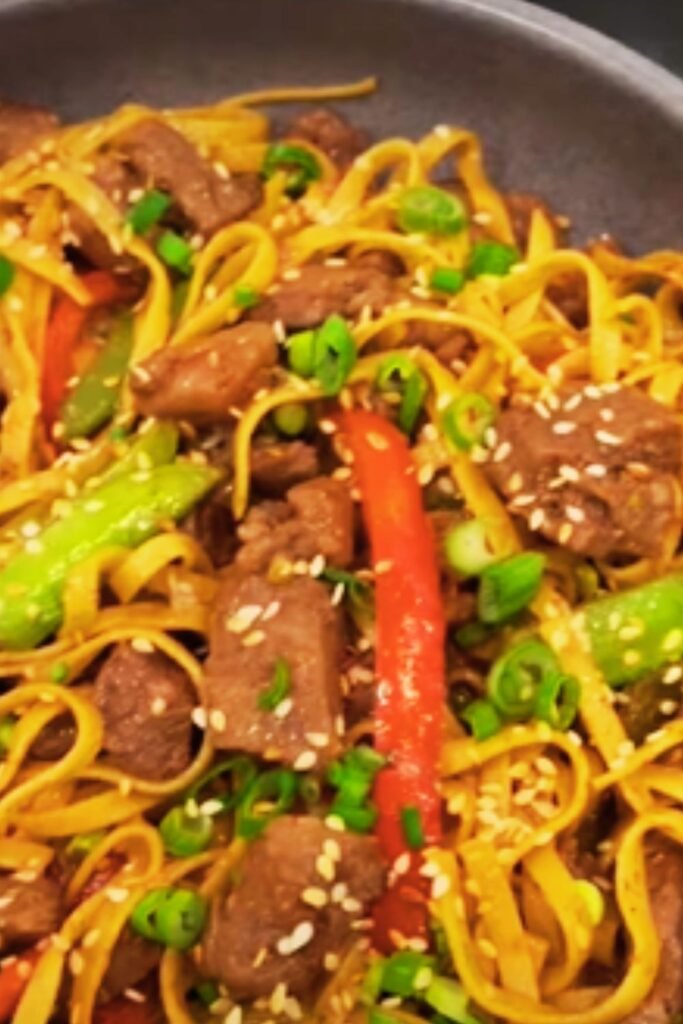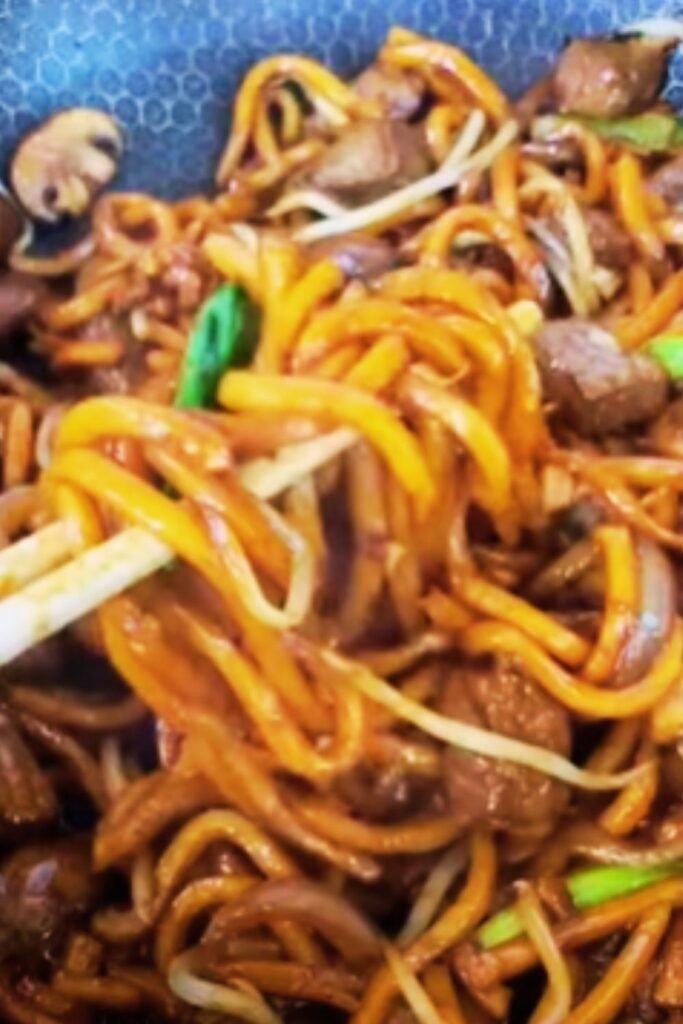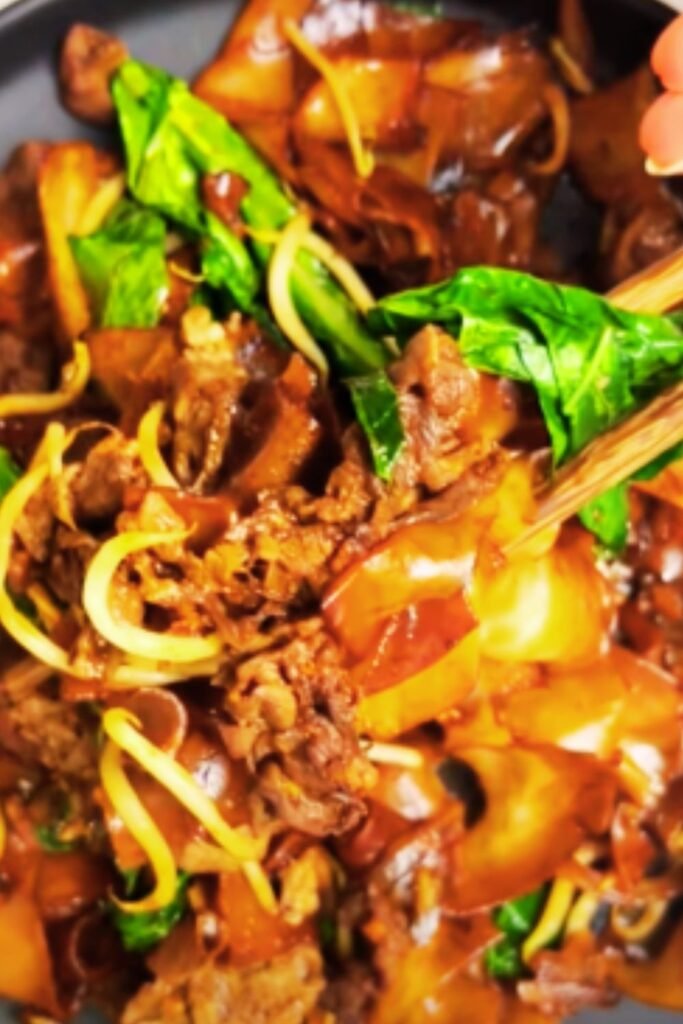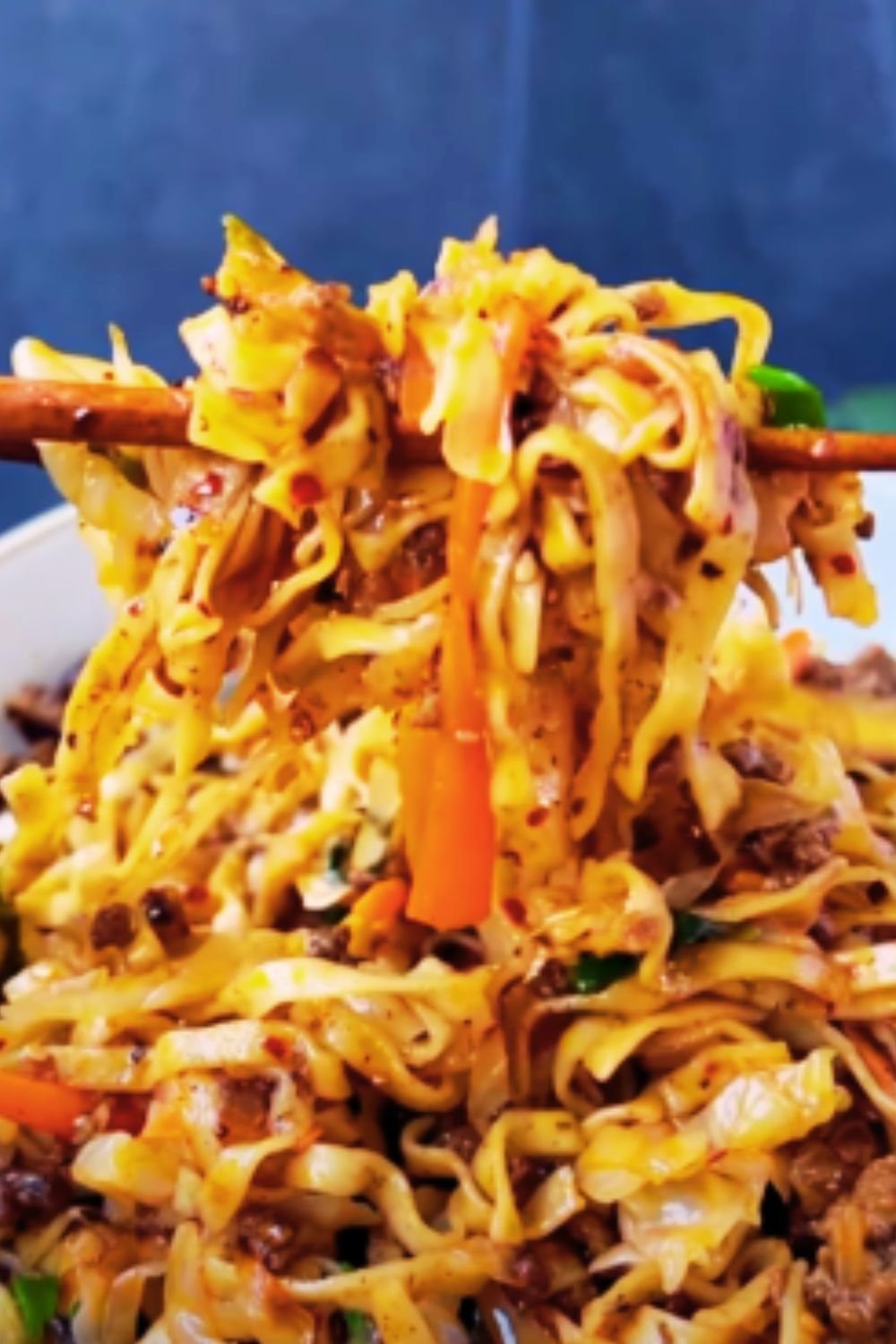There’s something magical about a sizzling pan of beef noodle stir fry that brings everyone to the table faster than you can say “dinner’s ready!” In my home, this dish has rescued countless hectic weeknights and has become one of our most requested meals. I’ve spent years perfecting this recipe, balancing flavors and techniques to create a dish that’s both authentic and approachable for home cooks.
What makes this beef noodle stir fry special isn’t just its incredible flavor—it’s the way it transforms simple ingredients into something extraordinary in just 15 minutes. That’s faster than delivery and infinitely more satisfying! The tender strips of beef, crisp vegetables, and slippery noodles coated in that savory-sweet sauce create a symphony of textures and tastes that never fails to delight even my pickiest eaters.
Today, I’m sharing my family’s treasured recipe, complete with all the tips and tricks I’ve discovered along the way. Whether you’re a stir fry novice or looking to perfect your technique, this comprehensive guide will help you create restaurant-quality beef noodle stir fry right in your own kitchen.
The Secret to Perfect Beef Noodle Stir Fry
The heart of any great stir fry lies in its preparation. Before I even turn on the stove, I make sure everything is prepped and within arm’s reach. This “mise en place” approach is crucial because once that wok heats up, things move incredibly fast.
My three non-negotiable secrets for an exceptional beef noodle stir fry are:
- Properly sliced beef – Always cut against the grain and slice thinly for maximum tenderness
- High heat cooking – A screaming hot pan creates that coveted “wok hei” flavor and perfect texture
- The right sauce balance – Finding that perfect harmony between salty, sweet, and umami flavors
Let’s break down each component of this dish to ensure you achieve stir fry perfection every time.
Ingredients You’ll Need
For the Beef and Marinade:
- 1 pound flank steak (or sirloin), thinly sliced against the grain
- 1 tablespoon soy sauce
- 1 tablespoon Shaoxing wine (or dry sherry)
- 1 teaspoon cornstarch
- 1/2 teaspoon baking soda (my secret for ultra-tender beef!)
- 1/4 teaspoon white pepper
For the Stir Fry Sauce:
- 3 tablespoons oyster sauce
- 2 tablespoons soy sauce
- 1 tablespoon dark soy sauce (for color and richness)
- 1 tablespoon Shaoxing wine
- 2 teaspoons brown sugar
- 1 teaspoon sesame oil
- 1/4 teaspoon white pepper
For the Stir Fry:
- 8 ounces noodles (lo mein, rice noodles, or udon)
- 2 tablespoons vegetable oil, divided
- 3 cloves garlic, minced
- 1 tablespoon fresh ginger, grated
- 1 medium onion, sliced
- 1 red bell pepper, julienned
- 2 cups broccoli florets, blanched
- 2 medium carrots, julienned
- 3 green onions, cut into 2-inch pieces
For Garnish:
- Toasted sesame seeds
- Thinly sliced green onions
- Red chili flakes (optional)
Essential Equipment
Having the right tools makes a world of difference when preparing stir fry. Here’s what I reach for:
- Wok or large skillet – A 12-14 inch wok or high-sided skillet provides enough space for ingredients to sear rather than steam
- Metal spatula or wooden spoon – For quick tossing and stirring
- Sharp knife – Essential for thinly slicing beef and vegetables
- Small bowls – For organizing prepped ingredients
- Large pot – For cooking noodles

Step-by-Step Instructions
Preparing the Beef
The way you prepare your beef can make or break your stir fry. I’ve learned that taking a few extra minutes to properly slice and marinate the meat pays enormous dividends in the final dish.
- Slice properly: Place your flank steak in the freezer for 15-20 minutes until firm but not frozen. This makes it much easier to slice thinly. Cut against the grain into 1/8-inch slices.
- Marinate effectively: In a medium bowl, combine the sliced beef with soy sauce, Shaoxing wine, cornstarch, baking soda, and white pepper. Mix well, ensuring each piece is coated. The baking soda breaks down the meat fibers, resulting in incredibly tender beef, while the cornstarch creates a protective coating that keeps the meat juicy.
- Rest and activate: Let the beef marinate for at least 15 minutes while you prepare the other ingredients. This short rest time allows the marinade to work its magic.
Preparing the Noodles
Different types of noodles require different preparation methods. Here’s a handy reference guide:
| Noodle Type | Cooking Time | Water Temperature | Special Notes |
|---|---|---|---|
| Lo Mein | 3-4 minutes | Boiling | Rinse with cold water after cooking |
| Rice Noodles | 6-8 minutes | Hot (not boiling) | Soak rather than boil, until al dente |
| Udon | 2-3 minutes | Boiling | Fresh udon cooks very quickly |
| Ramen | 2 minutes | Boiling | Slightly undercook as they’ll continue cooking in the stir fry |
| Soba | 4-5 minutes | Boiling | Rinse thoroughly with cold water after cooking |
For this recipe, I prefer lo mein noodles for their chewy texture and ability to hold up well against the bold flavors of the sauce.
- Cook your chosen noodles according to package directions, but aim for al dente as they’ll continue cooking in the stir fry.
- Drain thoroughly and toss with a small amount of oil to prevent sticking.
- Set aside while you prepare the rest of the stir fry.
Making the Sauce
The sauce is where the magic happens in a beef noodle stir fry. My recipe creates a perfectly balanced sauce that clings beautifully to both the noodles and ingredients.
- In a small bowl, combine all sauce ingredients: oyster sauce, soy sauce, dark soy sauce, Shaoxing wine, brown sugar, sesame oil, and white pepper.
- Whisk until the sugar is dissolved and the mixture is uniform.
- Taste and adjust seasonings if necessary—this sauce should be rich, savory, and just slightly sweet.
The Stir Fry Process
Now comes the fun part—the actual stir frying! This is where timing and technique are crucial.
- Heat your wok: Place your wok or large skillet over high heat until it just starts to smoke. This extremely high temperature is essential for proper stir frying.
- Cook the beef: Add 1 tablespoon of oil and swirl to coat. Add the marinated beef in a single layer and let it sear undisturbed for 30 seconds. Then stir fry for another 1-2 minutes until the beef is browned but still slightly pink inside. Remove the beef and set aside.
- Sauté aromatics: Add the remaining oil to the wok. Add garlic and ginger, stir frying for just 15-20 seconds until fragrant.
- Add vegetables: Add onions and stir fry for 1 minute until they begin to soften. Add bell peppers and carrots, stir frying for another 2 minutes. Add the blanched broccoli and green onions, tossing for 1 minute.
- Combine everything: Return the beef to the wok along with the cooked noodles. Pour the sauce over everything and toss continuously for 1-2 minutes until everything is well coated and heated through.
- Final touches: Taste and adjust seasonings if needed. If the sauce needs thickening, you can add a slurry of 1 teaspoon cornstarch mixed with 2 tablespoons water.

Common Stir Fry Mistakes to Avoid
Over the years, I’ve made (and corrected) just about every stir fry mistake possible. Here are the most common pitfalls to watch out for:
- Overcrowding the pan: This causes ingredients to steam rather than sear. If necessary, work in batches.
- Using low heat: Proper stir frying requires very high heat to achieve the right texture and flavor.
- Cutting ingredients inconsistently: Uniform sizes ensure everything cooks evenly.
- Adding sauce too early: This can make your vegetables soggy and prevent proper searing.
- Not preparing ingredients in advance: Once you start cooking, there’s no time to chop or measure.
Vegetable Substitutions and Additions
One of the beauties of stir fry is its adaptability. Here are some excellent vegetables you can substitute or add:
| Vegetable | Preparation | Cooking Time | Flavor Profile |
|---|---|---|---|
| Snow Peas | Strings removed | 1-2 minutes | Sweet, crisp |
| Bok Choy | Separated leaves/stems | 2-3 minutes | Mild, cabbage-like |
| Mushrooms | Sliced | 2-3 minutes | Earthy, umami |
| Bean Sprouts | Rinsed | 30-60 seconds | Crunchy, mild |
| Baby Corn | Halved | 2 minutes | Sweet, tender |
| Water Chestnuts | Sliced | 1-2 minutes | Crisp, nutty |
| Spinach | Whole leaves | 30 seconds | Mild, earthy |
Noodle Variations
While I’ve written this recipe with lo mein noodles in mind, you can easily substitute other types for variety:
- Udon noodles: Their chewy, thick texture stands up beautifully to the robust sauce
- Rice noodles: Create a lighter dish and are perfect for those avoiding wheat
- Soba noodles: Offer a nutty flavor and work well for a healthier twist
- Ramen noodles: Discard the flavor packet and use just the noodles for a quick alternative
- Egg noodles: Provide a rich, yellow color and tender texture
Protein Alternatives
Not in the mood for beef? No problem! This recipe works wonderfully with other proteins:
| Protein | Prep Method | Cooking Time | Special Notes |
|---|---|---|---|
| Chicken Breast | Thinly sliced | 3-4 minutes | Marinate similarly to beef |
| Shrimp | Peeled and deveined | 2-3 minutes | Cook just until pink |
| Tofu | Extra-firm, pressed, cubed | 3-4 minutes per side | Crisp before adding sauce |
| Pork Tenderloin | Thinly sliced | 3-4 minutes | Excellent with the same marinade |
| Thinly Sliced Lamb | Cut against grain | 2-3 minutes | Pairs wonderfully with these flavors |
Serving Suggestions
I love serving this beef noodle stir fry as a complete meal, but there are several ways to round out the dining experience:
- Pair with a simple cucumber salad dressed with rice vinegar and sesame oil
- Serve alongside steamed dumplings for a feast
- Offer chili oil or sambal oelek on the side for heat-lovers
- Add a light soup beforehand, like a simple egg drop or hot and sour
- Finish the meal with fresh fruit like mango or lychee for a refreshing contrast

Storage and Reheating Tips
One of the reasons I love making this beef noodle stir fry is that it makes fantastic leftovers—sometimes tasting even better the next day as the flavors meld together.
- Refrigeration: Store in an airtight container for up to 3 days.
- Freezing: While possible, I don’t recommend freezing this dish as the noodles can become mushy and the vegetables lose their texture.
- Reheating: For best results, reheat in a skillet with a splash of water or broth to rejuvenate the sauce. Microwave reheating works in a pinch, but the texture won’t be as good.
Health Benefits
Beyond being delicious, this beef noodle stir fry packs an impressive nutritional punch:
- Balanced macronutrients: Contains protein from beef, carbohydrates from noodles, and fiber from vegetables
- Rich in vitamins: Bell peppers provide vitamin C, while broccoli adds vitamins K and A
- Mineral-rich: Beef contributes iron and zinc, essential for energy and immune function
- Customizable: Easily adjusted to suit different dietary needs by varying proteins and noodle types
Questions and Answers
Q: Can I make this stir fry ahead of time for a dinner party?
While I understand the desire to prepare things in advance for entertaining, stir fry is truly at its best when freshly made. Instead of making the entire dish ahead, I recommend prepping all ingredients and making the sauce in advance. Store everything separately in the refrigerator, then cook just before serving. This approach takes only 15 minutes of actual cooking time but delivers that fresh-from-the-wok experience that makes stir fry special.
Q: My stir fry always ends up watery. What am I doing wrong?
This is one of the most common stir fry problems! There are three likely culprits: First, your pan may not be hot enough—it should be nearly smoking when you add ingredients. Second, you might be overcrowding the pan, which causes vegetables to steam rather than sear. Try cooking in batches if needed. Finally, ensure your vegetables are thoroughly dried after washing, as excess water contributes to sogginess.
Q: Is there a way to make this recipe gluten-free?
Absolutely! Use rice noodles instead of wheat-based ones, and substitute tamari for the soy sauce. Also make sure your oyster sauce is gluten-free (some brands contain wheat) or use a gluten-free alternative like Lee Kum Kee Gluten-Free Oyster Sauce. With these simple swaps, you’ll have a delicious gluten-free version that everyone can enjoy.
Q: Can I use ground beef instead of sliced beef?
While not traditional, ground beef can work in a pinch. If using ground beef, skip the marinating step and cook the beef first, breaking it into small pieces. Remove it from the wok and proceed with the recipe as written, returning the cooked ground beef when you would normally add back the sliced beef. The texture will be different, but the flavors will still be delicious.
Q: How spicy is this recipe? Can I make it kid-friendly?
As written, this recipe is very mild with just a hint of white pepper for warmth rather than heat. It’s already quite kid-friendly! For adults who enjoy spice, I recommend providing chili oil or sriracha at the table rather than making the entire dish spicy. This way, everyone can customize their own bowl to their preferred heat level.
Q: The ingredient list seems long. Are there any shortcuts I can take?
While each ingredient adds something to the final flavor, you can simplify if needed. For the marinade, just soy sauce and cornstarch will work in a pinch. For the sauce, oyster sauce and soy sauce are the most essential elements—the others add depth but aren’t strictly necessary. You can also use pre-cut vegetables from the grocery store to save on prep time.
Q: My beef always turns out tough. What’s the secret to tender beef in stir fry?
The three key factors for tender beef are: slicing thinly against the grain, using the baking soda in the marinade (which tenderizes the meat), and not overcooking. The beef should only be in the hot wok for 2-3 minutes total. It might still look slightly pink when you remove it from the wok the first time, but it will finish cooking when added back with the sauce.
The Joy of Stir Frying
What I love most about making beef noodle stir fry is the incredible satisfaction that comes from transforming simple ingredients into something spectacular in such a short time. There’s something almost meditative about the process—the rhythmic chopping during prep, the sizzle of ingredients hitting the hot wok, the aromatic cloud of steam that rises as the sauce meets the heat.
This dish represents everything I value about home cooking: efficiency, adaptability, nutritional balance, and most importantly, the ability to bring family together around the table. Even on our busiest days, this 15-minute meal allows us to connect over something homemade and delicious rather than resorting to takeout.
I hope this comprehensive guide helps you create a beef noodle stir fry that becomes a favorite in your household too. Remember that stir frying is as much about technique as it is about ingredients—with practice, you’ll develop an intuitive sense of timing and temperature that will elevate all your stir fries to restaurant quality.
Happy cooking, and may your wok always be sizzling!


